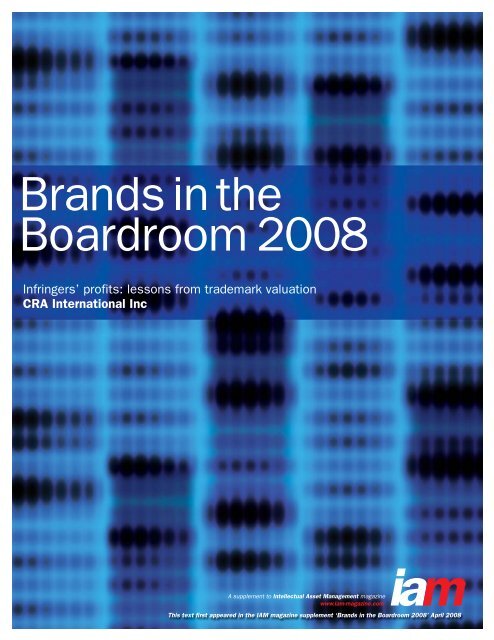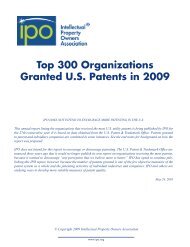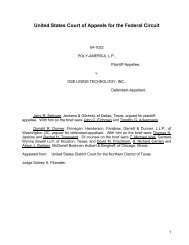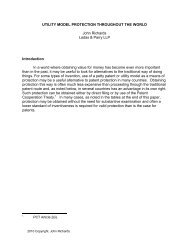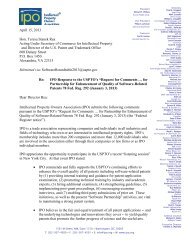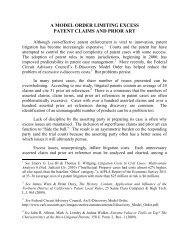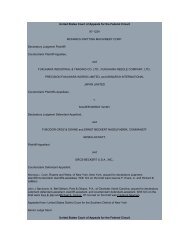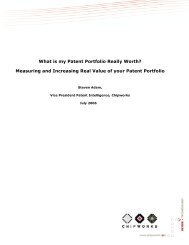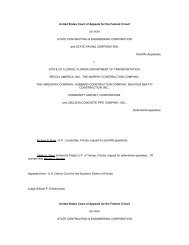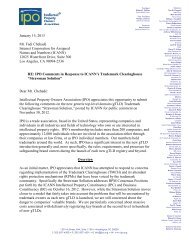Infringers' Profits - Intellectual Property Owners Association
Infringers' Profits - Intellectual Property Owners Association
Infringers' Profits - Intellectual Property Owners Association
Create successful ePaper yourself
Turn your PDF publications into a flip-book with our unique Google optimized e-Paper software.
Infringers’ profits: lessons from trademark valuation<br />
CRA International Inc<br />
This text first appeared in the IAM magazine supplement ‘Brands in the Boardroom 2008’ April 2008
Feature<br />
Infringers’ profits<br />
Infringers’ profits: lessons<br />
from trademark valuation<br />
By Scott D Phillips, CRA International Inc<br />
Trademark infringement and related causes<br />
of action in the United States sometimes<br />
include plaintiffs’ claims seeking infringers’<br />
profits. In some instances such claims have<br />
been described as excessive or<br />
disproportionate in the context of the<br />
defendant’s business or other facts. This<br />
article briefly describes some of the reasons<br />
why this occurs and outlines potential<br />
approaches to apportionment of infringers’<br />
profits which may help to solve the problem.<br />
In particular, it is proposed that generally<br />
accepted methods used by professional<br />
appraisers to conduct trademark valuation<br />
and similar projects may provide solutions.<br />
Background<br />
Plaintiffs in trademark infringement and<br />
related litigation generally seek injunctive<br />
relief and often also seek monetary awards<br />
in the form of plaintiffs’ damages and/or<br />
infringers’ profits. When seeking profits of the<br />
infringer, the Lanham Act provides that it is<br />
the plaintiff’s burden to prove the amount of<br />
the defendant’s sales, and that it is the<br />
defendant’s burden to prove its costs and<br />
other deductions. Consequently, the initial<br />
claims for infringers’ profits are often based<br />
on the defendant’s total revenues. Hence,<br />
infringers bear the burden of defending<br />
against a plaintiff’s claim that may exceed<br />
the defendant’s total profits by several orders<br />
of magnitude.<br />
Often the first effort expended is to call<br />
the accounting department to gather<br />
necessary information about costs of goods<br />
sold and other expenses. While such efforts<br />
are necessary, defendants sometimes<br />
overlook the more fundamental issue of the<br />
amount of their revenues that were impacted<br />
by the infringing mark or related action.<br />
Both business and legal professionals<br />
generally acknowledge that while trademarks<br />
and brands are important, they do not<br />
frequently account for all profits that a brand<br />
owner earns from the manufacture, distribution<br />
and marketing of products or services. For<br />
example, in addition to one or more brands,<br />
companies may invest significantly in property,<br />
plant, equipment, working capital, supply<br />
contracts and technology, among many other<br />
types of assets.<br />
Figure 1 provides an illustration of the<br />
relative value of brands to the total value of<br />
companies in a range of industries. It is<br />
apparent that brands are more or less<br />
valuable depending on the type of industry in<br />
which they are used. Further, within industry<br />
groups, brands are not all equally effective in<br />
generating profits and firm value. An extreme<br />
example of this may be the marketing of<br />
private label or generic products, where the<br />
brand is of much more limited value<br />
compared to its branded competitors. In such<br />
instances, factors other than brand feature<br />
more predominantly in consumer purchasing<br />
criteria and decisions.<br />
When confronted with a plaintiff’s<br />
monetary claim based on all of the<br />
defendant’s revenues, a primary issue the<br />
defendant might address is the portion of<br />
those revenues impacted by its use of the<br />
infringing trademark. This is one of the<br />
challenges involved in proving apportionment<br />
of the defendant’s profits. In the absence of<br />
evidence that the defendant’s sales were<br />
attributable to factors other than the<br />
infringing mark, it may be inferred or posited<br />
that such sales were entirely caused by use<br />
of the infringing mark.<br />
Valuation and apportionment techniques<br />
The valuation of trademarks is most<br />
commonly thought of in the context of<br />
determining a fair market value for a sale or<br />
purchase. However, there are a number of<br />
other contexts in which trademark valuation<br />
techniques have been useful. These include<br />
benchmarking for internal management,<br />
www.iam-magazine.com<br />
Brands in the Boardroom 2008 29
Infringers’ profits<br />
licensing and inter-company transfer pricing,<br />
among others.<br />
Both trademark valuation and accountings<br />
of defendant’s profits are conducted in the<br />
context of specific facts and circumstances<br />
which are unique to each project. For any<br />
given purpose, a valuation project typically<br />
involves a unique set of circumstances<br />
including the trademark itself, parties<br />
involved, geographic area, time period,<br />
product market, financial performance and<br />
other factors.<br />
Notwithstanding the uniqueness of<br />
each project, there are a number of valuation<br />
and apportionment techniques that can<br />
be considered.<br />
Standards and premises of value<br />
One of the determinants of brand valuation<br />
results is the “premise of value”. Standards<br />
and premises of value inform the appraiser<br />
about the conditions under which the property<br />
is to be valued and the scope of rights<br />
conveyed in the transaction. The most<br />
frequently cited standard of value is “fair<br />
market value”. Fair market value is defined<br />
as the amount at which an asset would<br />
change hands between a willing buyer and a<br />
willing seller within a commercially<br />
reasonable period of time, each having<br />
reasonable knowledge of the relevant facts,<br />
neither being under any compulsion to act<br />
and with equity to both. Other market<br />
conditions may also form the basis of the<br />
premise of value. These include going<br />
concern, liquidation, investment, replacement<br />
and other forms of value.<br />
In the context of litigation, a potential<br />
premise of value may be the “but-for” or<br />
“should-have-been” world, based on what<br />
would have occurred assuming that the<br />
alleged unlawful actions had not taken place.<br />
Thus, the challenge is to quantify the amount<br />
of income that would be impacted assuming<br />
that the defendant did not infringe a<br />
trademark or similar right. In the context of a<br />
defendant’s profits calculation, the premise<br />
of value will likely focus on the subject<br />
product line of the defendant’s business<br />
during the relevant time period. If impacted,<br />
the relevant income stream will be the<br />
amounts by which total income has changed.<br />
This change may be due to fewer units being<br />
sold, lower per unit price being received or<br />
higher costs incurred.<br />
In addition, the premise of value may<br />
include a description of the scope of rights<br />
conveyed in a transaction or, in the context of<br />
litigation, the scope of the infringing trademark<br />
in relation to other elements. Figure 2<br />
Figure 1. Brand equity as a percentage of firm replacement value<br />
70<br />
60<br />
50<br />
40<br />
30<br />
20<br />
10<br />
0<br />
Apparel<br />
(SIC 23)<br />
Printing &<br />
publishing<br />
(SIC 27)<br />
Tobacco<br />
(SIC 21)<br />
illustrates the manner in which the scope of<br />
rights might impact on the valuation analysis.<br />
For example, if the premise of value is<br />
global ownership and use of the trademark,<br />
the appraiser may capture 100% of a value<br />
pool. The value pool is an economic measure<br />
of the benefits realised by the user of a<br />
trademark (or other intellectual property).<br />
Alternatively, if the scope of rights conveyed<br />
in a transaction is, for example, a nonexclusive<br />
regional licence, the appraiser may<br />
attribute a smaller share of the total value<br />
pool to the licence. This reflects that the<br />
owner is retaining ownership rights that are<br />
not conveyed in the licence.<br />
Valuation methods<br />
As previously mentioned, a value pool is an<br />
economic measure of the benefits associated<br />
with the use of trademarks (or other<br />
intellectual property). A variety of techniques<br />
exist to measure the value pool and the<br />
ultimate valuation results. In the context of<br />
calculating infringers’ profits, these<br />
techniques may be useful in apportioning the<br />
economic impact of unlawful from otherwise<br />
unrelated actions. Described below are<br />
commonly used techniques.<br />
Cost approach<br />
The cost approach values assets based on<br />
the cost to create and develop the assets<br />
under consideration. Values determined<br />
using this approach are also viewed as the<br />
anticipated cost to replace an asset already<br />
owned should one lose use of it today. This<br />
Food<br />
products<br />
(SIC 20)<br />
Chemicals<br />
(SIC 28)<br />
Electric<br />
machinery<br />
(SIC 36)<br />
Figure 2. Illustrative composition<br />
of value pool<br />
Furniture &<br />
fixtures<br />
(SIC 25)<br />
Source: “The Measurement and Determination of Brand Equity: A Financial Approach”, Marketing Science, Winter, 1993<br />
Value pool<br />
Global ownership and use<br />
Global licensing<br />
Regional licensing<br />
Non-exclusive regional<br />
licensing<br />
30 Brands in the Boardroom 2008 www.iam-magazine.com
Infringers’ profits<br />
Figure 3. Illustrative calculation of excess<br />
earnings<br />
Branded<br />
Unbranded<br />
Average unit price $100 $70<br />
Incremental cost/unit $80 $60<br />
Incremental earnings/unit $20 $10<br />
Premium<br />
Excess earnings/unit $10<br />
valuation method is based on the premise<br />
that no party involved in an arm’s-length<br />
transaction would be willing to pay more to<br />
use the property than the cost to replace<br />
the property.<br />
The cost approach is often used to value<br />
new or relatively new property, or when<br />
information needed for other approaches is<br />
not available. However, the cost approach<br />
may involve several drawbacks for the<br />
valuation of trademarks and other intellectual<br />
property. The main limitation of this approach<br />
is its lack of consideration for all elements of<br />
income and/or profit streams, market<br />
conditions, useful life and the risk associated<br />
with receiving future economic benefits.<br />
Market approach<br />
The market approach values assets based on<br />
comparable transactions between unrelated<br />
parties. When considering potentially relevant<br />
transactions, it is necessary to evaluate the<br />
comparability of the market transactions.<br />
Factors which may be considered include<br />
company structure; relative balance of power<br />
between the parties; industry; market size;<br />
market share of the parties involved;<br />
profitability (both gross and net); any economic,<br />
legal, regulatory, political or other barriers to<br />
entry; new product introductions; and the<br />
growth outlook for the asset at issue. The time<br />
at which the comparable agreement took place<br />
may affect all of these factors and should be<br />
considered when analysing comparability. In<br />
addition, there may be other factors specific to<br />
a particular agreement that could significantly<br />
influence the value of the property.<br />
If exact comparables are available, the<br />
market approach may provide an indication of<br />
an asset’s value. By their very nature,<br />
trademarks and other intellectual property<br />
tend to be unique and therefore it is unusual<br />
to find exact comparables in this arena.<br />
However, inexact comparables might serve as<br />
a guide or indicator of value. Adjustments may<br />
be made to inexact comparables to<br />
compensate for differences in various factors.<br />
Income approach<br />
The income approach values assets based on<br />
the present value of income streams<br />
expected from the asset under consideration.<br />
It is one of the most widely used methods for<br />
determining values of intangible assets and<br />
intellectual property, including patents and<br />
trademarks. Three parameters are quantified<br />
in this method:<br />
• The income stream from the asset;<br />
• The duration of the income stream (ie, the<br />
remaining useful life of the asset); and<br />
• The risk associated with the realisation of<br />
the income stream.<br />
The duration of the income stream is<br />
determined by forecasting the useful life of<br />
the property or, in the context of litigation, the<br />
relevant damages period.<br />
The risk associated with the realisation of<br />
the income stream is addressed through the<br />
use of a discount rate. In the context of<br />
calculating historical profits, such discounting<br />
may not be necessary. However, when future<br />
profits are analysed, the risk of achieving<br />
future benefits may be considered.<br />
The income stream from the asset -<br />
usually a series of periodic amounts - may be<br />
quantified using a variety of approaches,<br />
depending on the specific circumstances of<br />
each case. The following is a discussion of<br />
some of the possible approaches to the<br />
quantification of income streams.<br />
Residual income approach: Economic<br />
benefits are rarely generated by intangible<br />
assets alone. Instead, working capital and<br />
tangible assets, such as property, plant and<br />
equipment, are usually combined to form a<br />
business enterprise. This collection of<br />
assets, when effectively managed, produces<br />
economic returns. By allocating the amount of<br />
return that is attributable to each of the<br />
business assets, it is possible to isolate the<br />
amount of return that is attributable to the<br />
intangible assets.<br />
The residual income approach deducts<br />
the income associated with all other assets in<br />
the business from total income to determine<br />
the amount of residual income attributable to<br />
the asset under consideration (eg, a<br />
trademark right or a patent right).<br />
Excess earnings approach: The excess<br />
earnings approach is based on the following<br />
premise: a property’s value can be measured<br />
by the incremental earnings achieved by a<br />
“branded” product relative to an essentially<br />
identical but “unbranded” product (ie, a<br />
“generic” version of the same product). The<br />
excess earnings may result from the<br />
“branded” product commanding a price<br />
premium, delivering certain manufacturing<br />
cost savings or achieving larger sales<br />
quantities. Figure 3 provides an example of<br />
an excess earnings calculation.<br />
Usually, the most significant challenge in<br />
attempting to use the excess earnings<br />
approach is finding a generic version of the<br />
“branded” product such that the only<br />
difference between the two is the presence or<br />
absence of the property being valued. It is<br />
www.iam-magazine.com<br />
Brands in the Boardroom 2008 31
Infringers’ profits<br />
important to consider whether other factors,<br />
aside from the property in question,<br />
contribute to the excess earnings achieved by<br />
the “branded” product. Examples of such<br />
factors include differences in the<br />
functionality/features of the products;<br />
differences in the post-sale and warranty<br />
services offered by each of the products; and<br />
differences in the costs of components and<br />
labour necessary to make each of the<br />
products. When such factors are present, the<br />
comparison may still be made, as long as<br />
adjustments can be made to account for the<br />
impact of these differences (ie, provided the<br />
appropriate data is available).<br />
Relief from royalty approach: The relief from<br />
royalty approach is based on the following<br />
premise: a property’s value can be measured<br />
by what the owner of the property would pay<br />
in royalties if it did not own the property and<br />
had to license it from a third party.<br />
This method requires the selection of a<br />
reasonable royalty. Such royalty rates may be<br />
determined by examining licences which<br />
provide for the use of similar or comparable<br />
trademarks. To the extent such licences are<br />
not comparable, adjustments to rates may be<br />
considered, or they may not provide a basis<br />
to quantify the relevant trademark earnings.<br />
Surveys: Surveys sometimes contain<br />
information that provides an understanding of<br />
the relative importance of trademarks in the<br />
context of consumer decision making. For<br />
example, surveys may ask consumers to rank<br />
or mention factors that influence their<br />
decisions. Such factors may include brand,<br />
price, location, quality, service,<br />
recommendations and many others. In the<br />
context of litigation, surveys which address<br />
the likelihood of confusion may be useful in<br />
developing an understanding of the “but-for”<br />
or “should-have-been” world. This is not to<br />
suggest that any particular survey ought or<br />
ought not to be used in a mechanical sense,<br />
since the capability of surveys to address<br />
monetary issues will vary based on their<br />
methods, subject matter and particular<br />
factual settings. However, such surveys may,<br />
to varying degrees, assist the appraiser in<br />
developing a better understanding of the<br />
economic issues.<br />
Trend analysis: The economic value of<br />
intellectual property may be evaluated by<br />
analysing sales and other trends. Changes in<br />
sales, market share or other economic<br />
metrics during one or more periods of time<br />
can be examined using trend analysis.<br />
Regression analysis is a technique commonly<br />
used to understand such trends. In the<br />
context of a trademark infringement action, for<br />
example, it may be possible to discern the<br />
impact of infringement on product<br />
performance and the competitive environment<br />
by analysing trends in sales or other data prior<br />
to, during and/or following infringing actions.<br />
Such changes may form a basis to understand<br />
economic value associated with a trademark.<br />
Of course, it is important to consider factors<br />
other than infringement which may potentially<br />
have impacted on sales or other aspects of<br />
the business.<br />
Conclusion<br />
The calculation of defendant’s profits in the<br />
context of a trademark infringement or similar<br />
action is often thought of as an accounting<br />
problem that consists of quantifying total<br />
sales and determining the deduction of<br />
appropriate costs and expenses. However,<br />
apportionment of profits also involves an<br />
assessment of the degree to which the<br />
defendant’s sales or costs have been<br />
impacted by having infringed the plaintiff’s<br />
trademark rights. Appraisal techniques relied<br />
on by trademark valuation professionals may<br />
also be useful in the context of the<br />
apportionment of defendant’s profits.<br />
The subjects and techniques in this article<br />
are presented for illustrative purposes and<br />
are not intended to reflect a comprehensive<br />
review of intellectual property valuation<br />
issues. Pertinent valuation issues and<br />
theories must be assessed on the basis of<br />
the particular factual and legal circumstances<br />
of each case. It is not meant to provide<br />
consulting advice with respect to any specific<br />
matter and should not be acted upon without<br />
professional advice. This article reflects the<br />
views of the author and not necessarily those<br />
of CRA International Inc or its employees.<br />
Scott D Phillips is a vice president and leader of the firm’s trademark<br />
practice, which focuses on the business aspects of trademarks, brand<br />
strategy and related areas. He has significant testimony experience in<br />
federal, state and tax court matters regarding the valuation of brands,<br />
patents, lost profits, reasonable royalties and businesses. Mr Phillips<br />
advises companies on valuation and pricing issues in the context of<br />
licensing, acquisitions, joint ventures, bankruptcy, restructuring and<br />
investment holding companies. He also assists companies and<br />
governmental agencies on IP strategy and compliance issues. Mr<br />
Phillips is a certified public accountant and received a BS in<br />
economics from Northern Michigan University and an MBA in finance<br />
from Michigan State University.<br />
Scott D Phillips<br />
Vice President<br />
Email: sphillips@crai.com<br />
Tel: +1 312 357 1000<br />
CRA International Inc<br />
USA<br />
www.crai.com<br />
32 Brands in the Boardroom 2008 www.iam-magazine.com


